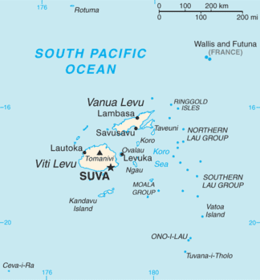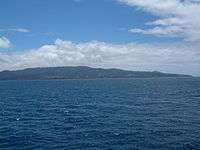Lahloo (clipper)
_-_SLV_H91.250-135.jpg) Lahloo | |
| History | |
|---|---|
| Name: | Lahloo |
| Owner: | James Findlay |
| Builder: | Robert Steele & Co., Greenock, for Alexander Rodger, Glasgow |
| Launched: | July 23, 1867 |
| Fate: | Lost Sandalwood Island, July 30 or 31, 1872 16°35′S 179°11′E / 16.583°S 179.183°E |
| General characteristics | |
| Tons burthen: | 799 tons, 985 83/94 tons OM |
| Length: | 191 ft. 6 in. |
| Beam: | 32 ft. 9 in. |
| Draught: | 19 ft. 9 in.[1][2] |
The Lahloo was a British Tea Clipper known for winning the Tea Race of 1870, and finishing second in the Tea Race of 1871. She sailed from Foochow to London with over a million pounds (500 tons) of tea in 1868.[2]
Construction
Lahloo was of the same class and sharpness as Ariel, "with more deadrise and tumblehome and a slightly fuller run."[3] She was designed by William Steele, had a composite hull, and carried Cunningham's roller-reefing topsails.[4]
Voyages
- Foochow to London
- 101 days, 1868
- 101 days, 1869
- 111 days, 1871
- London to Shanghai
- 98 days (95 days pilot to pilot)[2]
Won the Tea Race of 1870
"The race of 1870 from Foo-chow to London was won by the Lahloo in 97 days, the other vessels being: the Windhover, 100 days; Sir Launcelot, 102 days; Leander, 103 days; Thermopylae, 106 days."[5]
Finished second in the Tea Race of 1871
"In 1871 the Titania won in 93 days; the Lahloo, 111 days, from Foo-chow to London; and from Shanghai to London the Thermopylae was 106 days; Cutty Sark, 110 days, and Forward Ho, 118 days. This was about the last of the tea clipper racing, for the combined competition of steam and the Suez Canal proved too powerful for sail. No more tea clippers were built after 1869; by degrees these beautiful vessels were driven into other trades; and so the Clipper Ship Era drifted into history."[5]
Sailing performance
According to Lubbock, the tea clippers Lahloo, Fiery Cross, Taeping and Serica performed at their best in light breezes, as they were all rigged with single topsails.[6]
Loss of the ship


The Lahloo was wrecked on Sandalwood Island, Sunda Islands, on July 31, 1872 (photograph states July 30), on a voyage from Shanghai to London with tea.[2]
References
- ↑ Lubbock, Basil (1919). The China Clippers (4th ed.). Glasgow: James Brown & Son. p. iv.
- 1 2 3 4 Bruzelius, Lars (Dec 26, 1996). "Sailing Ships: Lahloo (1867)". Lahloo. The Maritime History Virtual Archives. Retrieved March 18, 2011.
- ↑ MacGregor, David R (1983). The tea clippers: their history and development, 1833-1875. Annapolis, MD: Naval Institute Press. p. 180. ISBN 978-0-87021-884-2.
- ↑ Lars Bruzelius (2003-04-28). "Cunningham's Patent Self-Reefing Topsails". Retrieved 2010-02-19.
- 1 2 Clark, Arthur H. (1910). The Clipper Ship Era, An Epitome of Famous American and British Clipper Ships, Their Owners, Builders, Commanders, and Crews, 1843-1869. Camden, ME: G.P. Putnam’s Sons. p. 336.
- ↑ Lubbock, Basil (1919). The China Clippers (4th ed.). Glasgow: James Brown & Son. p. 155.
Further reading
- Robinson, J (1995). China clipper master: the story of John Smith of the "Lahloo". Glasgow: Brown, Son & Ferguson. ISBN 978-0-85174-628-9.
External links
- Lahloo Tea, company founded by great-great granddaughter of a man who sailed on the ship
- Description of the Tea Race of 1871
- Lithograph of Lahloo
- Betting on Lahloo for upcoming Tea Race
- Account of 1868 Tea Race
- Account of the wreck of the Lahloo